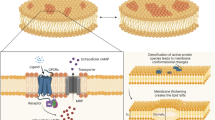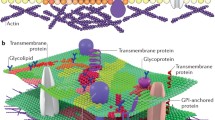Summary
Raft membrane domains are envisioned as lateral assemblies of cholesterol and sphingolipids which adopt a liquid-ordered membrane phase. Our understanding of the raft architecture in cell membranes is developing rapidly. The current view describes raft domains as small and highly dynamic subdomains of cell membranes. The size and stability of raft domains are essential parameters which determine the function of raft domains in cells. Here we discuss how the architecture and stability of raft domains is regulated by oligomerisation of raft components and by modulation of their molecular composition.
Similar content being viewed by others
Abbreviations
- DIGs:
-
detergent-insoluble glycolipid-enriched membranes
- GPI:
-
glycosylphosphatidylinositol
- PDZ:
-
PSD95/discslarge/ZO-1
- PI:
-
phosphoinositide
- PIP2 :
-
phosphatidylinositol 4,5-bisphosphate
- TCR:
-
T-cell receptor
References
Ahmed SN, Brown DA, London E (1997) On the origin of sphingolipid/cholesterol-rich detergent-insoluble cell membranes: physiological concentrations of cholesterol and sphingolipid induce formation of a detergent-insoluble, liquid-ordered lipid phase in model membranes. Biochemistry 36: 10944–10953
Brown DA, London E (1997) Structure of detergent-resistant membrane domains: does phase separation occur in biological membranes? Biochem Biophys Res Commun 240: 1–7
— — (1998) Functions of lipid rafts in biological membranes. Annu Rev Cell Dev Biol 14: 111–136
—, Rose JK (1992) Sorting of GPI-anchored proteins to glycolipid-enriched membrane subdomains during transport to the apical cell surface. Cell 68: 533–544
Brückner K, Labrador JP, Scheiffele P, Herbst A, Seeburg PH, Klein R (1999) EphrinB ligands recruit GRIP family PDZ adaptor proteins into raft membrane microdomains. Neuron 22: 511–524
Craven SE, El-Husseini AE, Bredt DS (1999) Synaptic targeting of the postsynaptic density protein PSD-95 mediated by lipid and protein motifs. Neuron 22: 497–509
De Angelis DA, Miesenbock G, Zemelman BV, Rothman JE (1998) PRIM: proximity imaging of green fluorescent protein-tagged polypeptides. Proc Natl Acad Sci USA 95: 12312–12316
Dupree P, Parton RG, Raposo G, Kurzchalia TV, Simons K (1993) Caveolae and sorting in the trans-Golgi network of epithelial cells. EMBO J 1993 12: 1597–1605
Dustin ML, Shaw AS (1999) Costimulation: building an immunological synapse. Science 283: 649–650
Friedrichson T, Kurzchalia TV (1998) Microdomains of GPI-anchored proteins in living cells revealed by crosslinking. Nature 394: 802–805
Fukami K, Endo T, Imamura M, Takenawa T (1994) Alpha-actinin and vinculin are PIP2-binding proteins involved in signaling by tyrosine kinase. J Biol Chem 269: 1518–1522
Futerman AH, Boldin S, Brann AB, Schwarz A, Zisling R (1998) Regulatory roles for sphingolipids in the growth of polarized neurons. Ann N Y Acad Sci 845: 176–187
Harder T, Simons K (1999) Clusters of glycolipid and glycosylphosphatidylinositol-anchored proteins in lymphoid cells: accumulation of actin regulated by local tyrosine phosphorylation. Eur J Immunol 29: 556–562
Holowka D, Baird B (1996) Antigen-mediated IGE receptor aggregation and signaling: a window on cell surface structure and dynamics. Annu Rev Biophys Biomol Struct 25: 79–112
Hope HR, Pike LJ (1996) Phosphoinositides and phosphoinositide-utilizing enzymes in detergent-insoluble lipid domains. Mol Biol Cell 7: 843–851
Hsueh YP, Kim E, Sheng M (1997) Disulfide-linked head-to-head multimerization in the mechanism of ion channel clustering by PSD-95. Neuron 18: 803–814
Kabouridis PS, Magee AI, Ley SC (1997) S-acylation of LCK protein tyrosine kinase is essential for its signalling function in T lymphocytes. EMBO J 16: 4983–4998
Kupfer A, Swain SL, Singer SJ (1987) The specific direct interaction of helper T cells and antigen-presenting B cells II: reorientation of the microtubule organizing center and reorganization of the membrane-associated cytoskeleton inside the bound helper T cells. J Exp Med 165: 1565–1580
Ledesma MD, Brugger B, Bünning C, Wieland FT, Dotti CG (1999) Maturation of the axonal plasma membrane requires upregulation of sphingomyelin synthesis and formation of protein-lipid complexes. EMBO J 18: 1761–1771
Liu Y, Casey L, Pike LJ (1998) Compartmentalization of phosphatidylinositol 4,5-bisphosphate in low-density membrane domains in the absence of caveolin. Biochem Biophys Res Commun 245: 684–690
Mayor S, Rothberg KG, Maxfield FR (1994) Sequestration of GPI-anchored proteins in caveolae triggered by cross-linking. Science 264: 1948–1951
Melkonian KA, Ostermeyer AG, Chen JZ, Roth MG, Brown DA (1999) Role of lipid modifications in targeting proteins to detergent-resistant membrane rafts: many raft proteins are acylated, while few are prenylated. J Biol Chem 274: 3910–3917
Monks CR, Freiberg BA, Kupfer H, Sciaky N, Kupfer A (1998) Three-dimensional segregation of supramolecular activation clusters in T cells. Nature 395: 82–86
Montixi C, Langlet C, Bernard AM, Thimonier J, Dubois C, Wurbel MA, Chauvin JP, Pierres M, He HT (1998) Engagement of T cell receptor triggers its recruitment to low-density detergent-insoluble membrane domains. EMBO J 17: 5334–5348
Moran M, Miceli MC (1998) Engagement of GPI-linked CD48 contributes to TCR signals and cytoskeletal reorganization: a role for lipid rafts in T cell activation. Immunity 9: 787–796
Okamoto T, Schlegel A, Scherer PE, Lisanti MP (1998) Caveolins, a family of scaffolding proteins for organizing “preassembled signaling complexes” at the plasma membrane. J Biol Chem 273: 5419–5422
Parton RG (1996) Caveolae and caveolins. Curr Opin Cell Biol 8: 542–548
Perez AS, Bredt DS (1998) The N-terminal PDZ-containing region of postsynaptic density-95 mediates association with caveolar-like lipid domains. Neurosci Lett 258: 121–123
Pike LJ, Casey L (1996) Localization and turnover of phosphatidylinositol 4,5-bisphosphate in caveolin-enriched membrane domains. J Biol Chem 271: 26453–26456
Reif K, Cantrell DA (1998) Networking Rho family GTPases in lymphocytes. Immunity 8: 395–401
Rodgers W, Crise B, Rose JK (1994) Signals determining protein tyrosine kinase and glycosyl-phosphatidylinositol-anchored protein targeting to a glycolipid-enriched membrane fraction. Mol Cell Biol 14: 5384–5391
Scheiffele P, Roth MG, Simons K (1997) Interaction of influenza virus haemagglutinin with sphingolipid-cholesterol membrane domains via its transmembrane domain. EMBO J 16: 5501–5508
—, Verkade P, Fra AM, Virta H, Simons K, Ikonen E (1998) Caveolin-1 and -2 in the exocytic pathway of MDCK cells. J Cell Biol 140: 795–806
Schroeder R, London E, Brown D (1994) Interactions between saturated acyl chains confer detergent resistance on lipids and glycosylphosphatidylinositol (GPI)-anchored proteins: GPI-anchored proteins in liposomes and cells show similar behavior. Proc Natl Acad Sci USA 91: 12130–12134
Shenoy-Scaria AM, Dietzen DJ, Kwong J, Link DC, Lublin DM (1994) Cysteine3 of Src family protein tyrosine kinase determines palmitoylation and localization in caveolae. J Cell Biol 126: 353–363
Simons K, Ikonen E (1997) Functional rafts in cell membranes. Nature 387: 569–572
Stauffer TP, Meyer T (1997) Compartmentalized IgE receptor-mediated signal transduction in living cells. J Cell Biol 139: 1447–1454
—, Ahn S, Meyer T (1998) Receptor-induced transient reduction in plasma membrane PtdIns(4,5)P2 concentration monitored in living cells. Curr Biol 8: 343–346
Thomas JL, Holowka D, Baird B, Webb WW (1994) Large-scale co-aggregation of fluorescent lipid probes with cell surface proteins. J Cell Biol 125: 795–802
Valitutti S, Dessing M, Aktories K, Gallati H, Lanzavecchia A (1995a) Sustained signaling leading to T cell activation results from prolonged T cell receptor occupancy: role of T cell actin cytoskeleton. J Exp Med 181: 577–584
—, Muller S, Cella M, Padovan E, Lanzavecchia A (1995b) Serial triggering of many T-cell receptors by a few peptide-MHC complexes. Nature 375: 148–151
Varma R, Mayor S (1998) GPI-anchored proteins are organized in submicron domains at the cell surface. Nature 394: 798–801
Vaz WL, Almeida PF (1993) Phase topology and percolation in multi-phase bilayers: is the biological membrane a domain mosaic? Curr Opin Struct Biol 3: 482–488
Viola A, Lanzavecchia A (1996) T cell activation determined by T cell receptor number and tunable thresholds. Science 273: 104–106
—, Schroeder S, Sakakibara Y, Lanzavecchia A (1999) T lymphocyte costimulation mediated by reorganization of membrane microdomains. Science 283: 680–682
Wary KK, Mariotti A, Zurzolo C, Giancotti FG (1998) A requirement for caveolin-1 and associated kinase Fyn in integrin signaling and anchorage-dependent cell growth. Cell 94: 625–634
Wülfing C, Davis MM (1998) A receptor/cytoskeletal movement triggered by costimulation during T cell activation. Science 282: 2266–2269
Xavier R, Brennan T, Li Q, McCormack C, Seed B (1998) Membrane compartmentation is required for efficient T cell activation. Immunity 8: 723–732
Zhang W, Trible RP, Samelson LE (1998) LAT palmitoylation: its essential role in membrane microdomain targeting and tyrosine phosphorylation during T cell activation. Immunity 9: 239–246
Author information
Authors and Affiliations
Rights and permissions
About this article
Cite this article
Harder, T., Scheiffele, P. Regulation of raft architecture. Protoplasma 212, 1–7 (2000). https://doi.org/10.1007/BF01279341
Received:
Accepted:
Issue Date:
DOI: https://doi.org/10.1007/BF01279341




